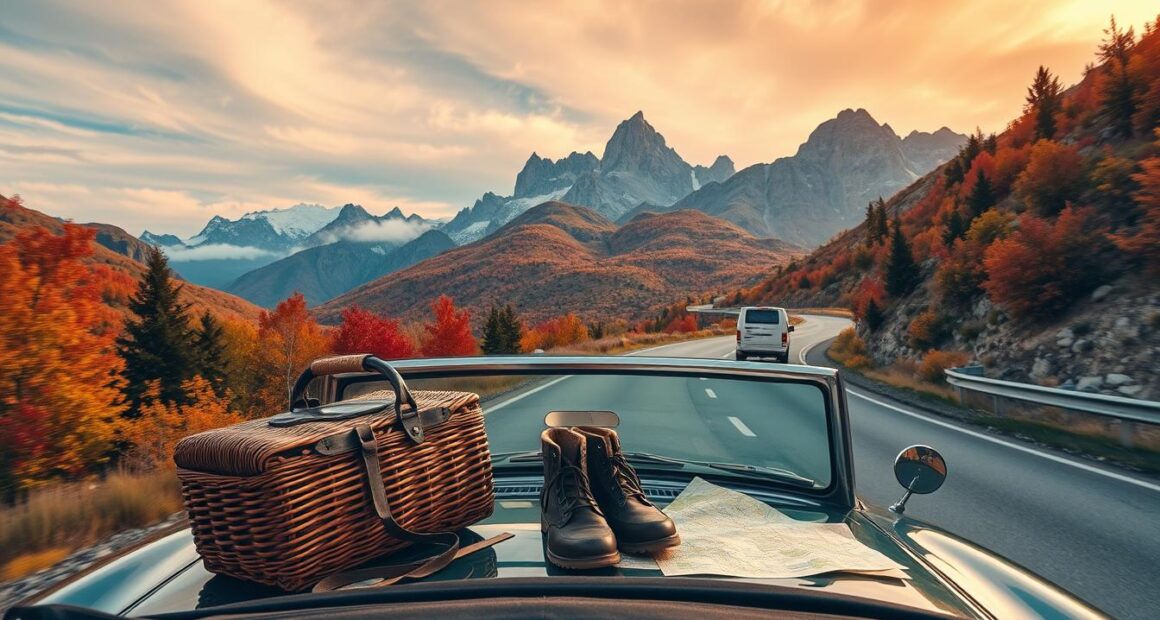There’s a certain magic that fills the air when you set out on a road trip, a captivating sense of freedom that reminds you how vast and beautiful our world truly is. Each mile traveled brings with it the promise of adventure, laughter, and unforgettable memories with those you hold dear. As the tires hum rhythmically against the pavement and the horizon unveils its marvels, thoughtful planning intertwines with delightful spontaneity, crafting experiences that you will treasure forever. Whether it’s the thrill of serendipitously uncovering a charming roadside diner or the joy of sharing stories with friends during long stretches of open road, having essential road trip tips in your back pocket ensures that every journey is as enjoyable as the destination. In fact, about 70% of road trippers consider snacks crucial for enjoyable voyages, while 65% believe solid planning enhances their experience immensely12. So, buckle up as we embark on a journey filled with insights and advice that will help make your road trip truly unforgettable. As you prepare for your adventure, remember that flexibility is key; the best memories often stem from unplanned detours and unexpected stops along the way. Keeping an open mind and embracing the journey will lead you to hidden gems that aren’t on the map. To help you navigate this dreamlike experience, here are some essential tips for a successful road trip that will elevate your journey and ensure that you and your companions make the most of every moment spent on the road.
Key Takeaways
- Plan your route carefully to make the most of your journey.
- Check vehicle readiness to avoid breakdowns on the road.
- Pack snacks to keep energy levels up and save on food costs.
- Include entertainment options like playlists and audiobooks.
- Make spontaneous stops to discover hidden gems.
- Prioritize safety with regular breaks and adherence to traffic laws.
- Be flexible and open to adapting your plans for unique experiences.
Plan Your Route Wisely
Effective road trip planning hinges on how well you prepare your route. You can enhance your travel experience through route optimization, ensuring you don’t miss out on stunning locations or interesting attractions along the way.
Utilize GPS and Maps
Embracing technology is key with GPS navigation and digital maps offering real-time updates. On average, road trip budgets range from $600 to $1,200 per person, and incorporating these tools significantly improves your planning efficiency by saving up to 6 hours compared to more traditional methods3. For more complex trips, a robust travel plan outlines every direction and distance accurately, which 70% of travelers utilize with tools like Google Maps3.
Explore Scenic Byways
Scenic byways provide breathtaking views that elevate your journey from mere travel to an unforgettable adventure. With more than a million miles traversed by road trip enthusiasts over recent decades, it’s clear that the joy of spontaneous detours can lead to unique roadside attractions4. Many travelers appreciate that unexpected stops and detours are often their favorite part of road trips, as around 40% have reported3. Embrace the beauty of nature while allowing time for unplanned experiences, which often create the best memories.
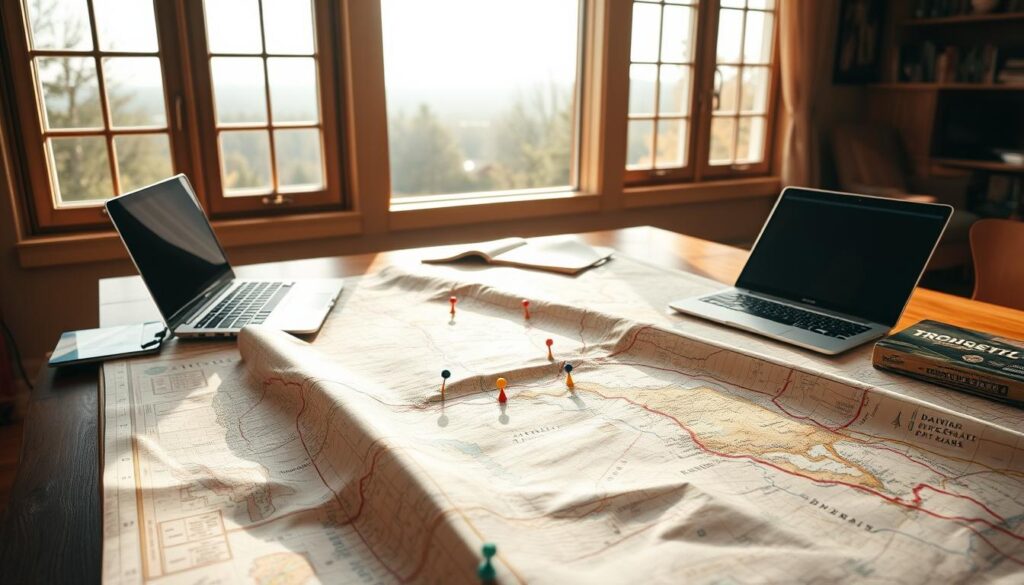
Prepare Your Vehicle
Your vehicle plays a crucial role in ensuring a smooth road trip adventure. Prior to hitting the road, it’s important to perform thorough checks to prevent potential setbacks. In fact, over 72% of drivers report experiencing car trouble while on a road trip, underscoring the significance of pre-trip vehicle preparation5. Start by checking the vital fluid levels, such as oil, coolant, and brake fluid, as nearly 50% of drivers neglect this essential step before long drives5. Such oversight can lead to serious complications on the road.
Check Fluid Levels
Checking fluid levels is a simple but vital part of vehicle maintenance. Ensuring adequate engine oil can significantly reduce the risk of engine failure, which can increase by 25% when regular oil changes are skipped5. Additionally, proper coolant and brake fluid levels contribute to a safer driving experience.
Inspect Tires
Next, inspect your tires to avoid any mishaps. It’s reported that 90% of tire blowouts stem from improper tire pressure, so verifying both air pressure and tread depth is essential5. Regular checks on these can prevent dangerous situations during your journey.
Pack an Emergency Kit
A well-stocked emergency kit is crucial. Approximately 45% of drivers do not carry one, which can be pivotal in addressing unforeseen issues on the road5. Your emergency kit should include essential items such as tools, flares, a flashlight, and a first-aid kit. An effective toolkit can mitigate stress in case of a breakdown. Having roadside assistance can enhance peace of mind, reducing the stress of potential breakdowns by 60%5.
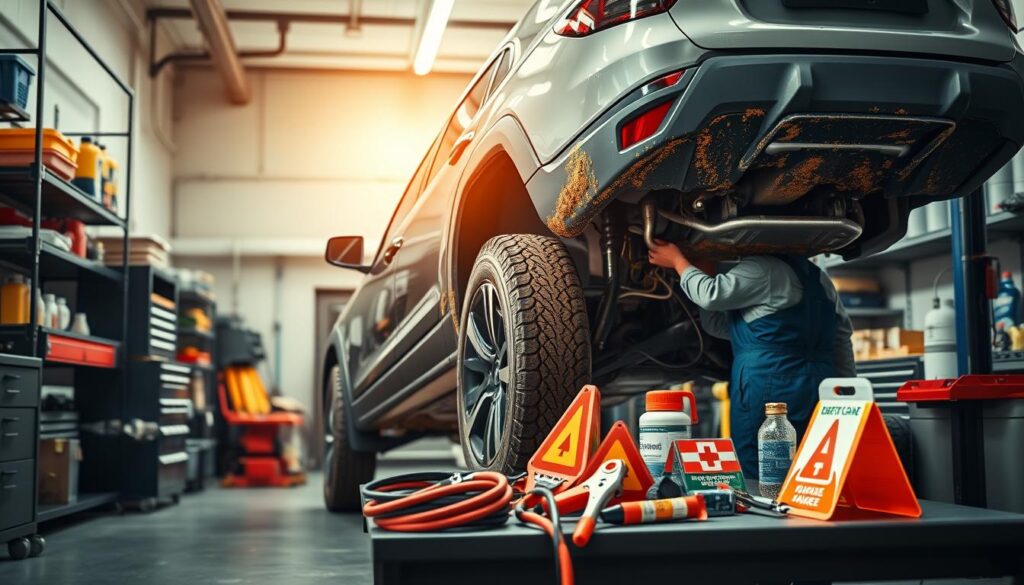
Pack Smart and Light
Packing efficiently for your road trip can significantly enhance your travel experience. Creating a detailed packing list is vital; it ensures you don’t overlook travel essentials like toiletries and chargers. By following effective packing tips, you can keep your luggage light and organized.
Create a Packing List
Start with a road trip checklist that includes all necessary items. Limit your clothing to about one week’s worth, which typically consists of 6-7 shirts, 7 pairs of underwear, and 3 pairs of pants. For specific climates, adjust items accordingly. For instance, tropical weather might necessitate fewer socks, while colder climates require more. To adhere to packing efficiency, consider that a typical carry-on bag should have a maximum capacity of 35 to 40 liters and should not exceed a recommended weight limit of 10 kg (22 lbs)6.
Consider Comfort Items
Aside from basic necessities, consider comfort items that enhance your journey. A travel pillow or a lightweight blanket can make long hours on the road far more enjoyable. Multi-functional clothing is another great investment as it can replace several items, reducing your overall luggage volume. For instance, high-quality merino wool clothing can keep you warm and dries quickly while being lightweight7.
Don’t Forget Snacks
Snacks play a crucial role in minimizing unnecessary stops and keep travel costs in check. Opt for healthy options like fruits, nuts, granola bars, alongside hydration sources such as reusable bottles filled with water or coffee. By packing snacks, you avoid potential “pit stops” that could derail your schedule.
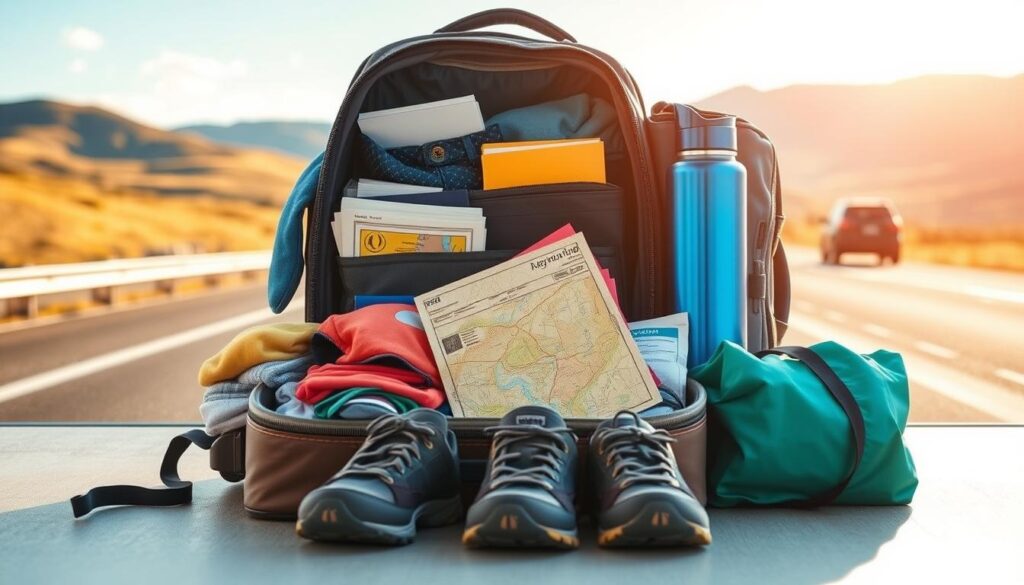
Keep Your Budget in Check
Managing your travel budget is essential for a memorable road trip experience. You will want to keep track of your road trip costs, as they can quickly add up if you’re not careful. To start, pay close attention to fuel expenses, as fuel is often one of the largest costs associated with road travel. Fuel-efficient vehicles, such as the Chevy Equinox, Subaru Crosstrek, and Honda HR-V, can help mitigate these expenses significantly8. Using apps like GasBuddy can assist in finding the lowest gas prices, which vary between major cities and rural areas8.
Fuel Expenses
Estimating fuel costs is a crucial part of budgeting for your trip. It can be helpful to know that gas stations typically increase their prices on Thursday afternoons, coinciding with the start of weekend road trips, making Tuesday or Wednesday the best days to fuel up8. To avoid high road trip costs related to fuel, incorporate multiple fuel stops along your planned route, especially in less populated areas where prices tend to be more stable.
Accommodation Costs
Accommodation costs can greatly affect your budget. Booking your stay in advance can lead to savings of up to 20-30% compared to making last-minute plans during peak seasons9. Consider unique options like camping at public lands, which may be free or cost-effective compared to typical hotel rates10. Staying outside major cities can save you approximately 10-50% on lodging, depending on the area9.
Budget-Friendly Activities
Engaging in budget-friendly activities can enhance your road trip without blowing your budget. Free activities like park visits and hiking not only offer enjoyment but also significantly lower your entertainment expenses10. Preparing your own meals while on the road can lead to savings of 40-60% compared to dining out regularly9. Moreover, local activities, such as fruit picking at orchards or attending community theater performances, provide delightful experiences without hefty price tags10.
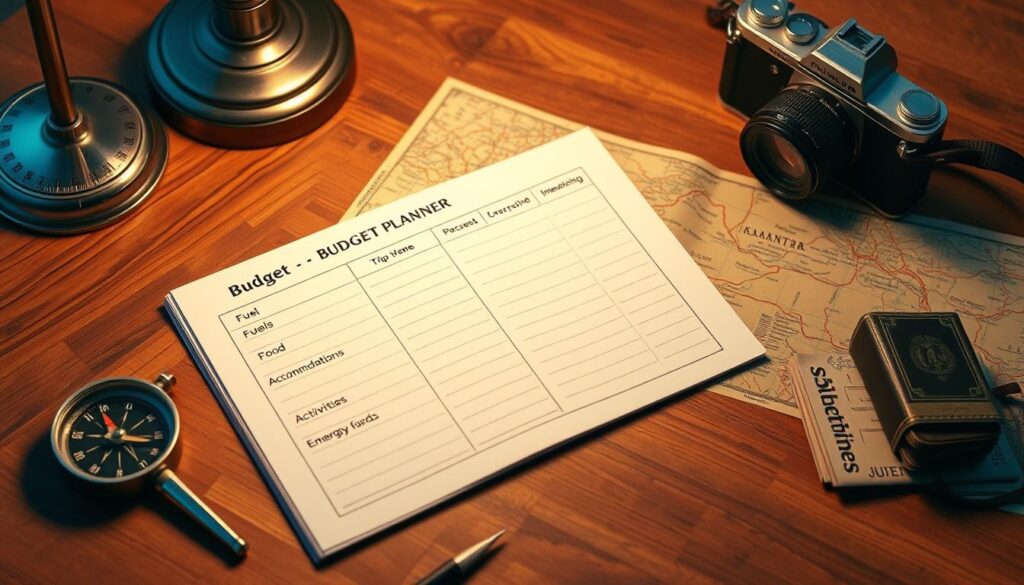
Make Fun Stops
Integrating enjoyable stops into your road trip can transform your journey into an unforgettable adventure. As you explore, keep an eye out for historic attractions that add cultural depth. These landmarks enrich your experience and often tell fascinating stories about the area you’re visiting. In addition, local food options provide an authentic taste of the region, allowing you to indulge in unique dishes that reflect local traditions.
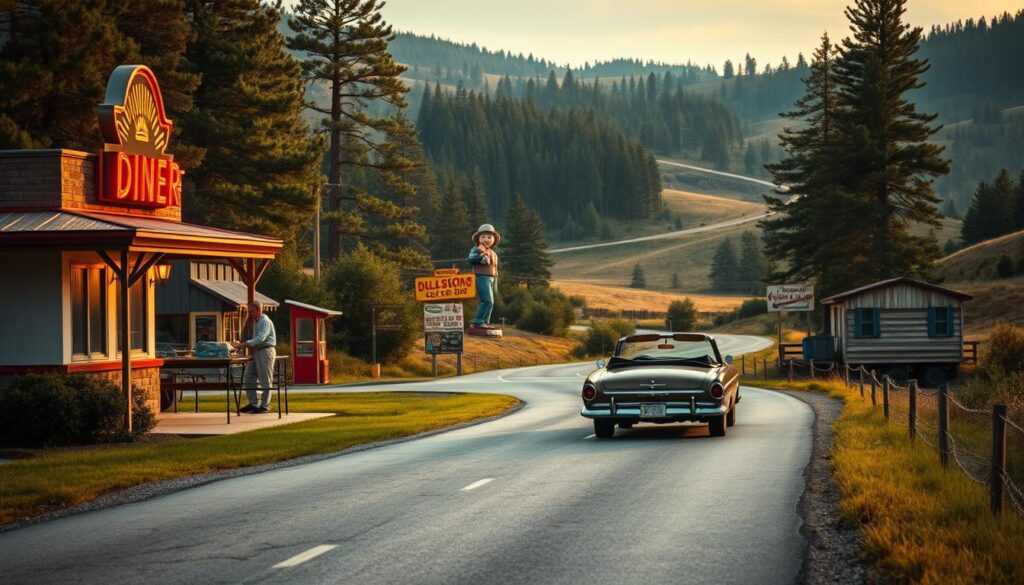
Historic Landmarks
Visiting historic landmarks not only offers a chance to step back in time but also introduces you to local narratives that shape a community’s identity. Sites such as battlefields, old forts, and preserved towns often include interactive elements that engage visitors, making the experience memorable.
Local Eateries
Don’t miss the opportunity to dine at local eateries where you can taste homemade dishes. Sampling local food reveals the culinary diversity of each destination and can be one of the highlights of your trip. Roadtrippers, a popular planning tool, highlights millions of tourist preferences for local dining experiences, connecting users with authentic flavors along their route11.
National Parks
National parks serve as a tranquil escape into nature, perfect for outdoor enthusiasts looking to hike, camp, or just unwind surrounded by stunning landscapes. Many travelers report that making stops at national parks enhances their overall enjoyment of the journey, allowing quality time spent with family and friends12. Prioritizing breaks every two to three hours not only helps maintain alertness but also offers opportunities to enjoy these breathtaking sites along the way13.
Entertain Yourself on the Road
Long hours on the road call for creative road trip entertainment. Keeping engaged during your journey ensures a lively atmosphere and memorable moments. Here are some fun ways to make the most of your time while traveling.
Play Road Trip Games
Road trip games such as “Twenty Questions” and scavenger hunts can create interactive fun for families and friends. Approximately 70% of road trip participants engage in travel games, which significantly helps in combating boredom, especially among children14. Playing these games fosters bonding while enhancing engagement among travelers, making every mile enjoyable.
Create a Customized Playlist
Curating a personal music playlist transforms your travel experience. Studies show that 68% of road trippers consider music vital for entertainment during their journeys15. Including your favorite tunes, audiobooks, or podcasts, especially stories related to your route, can deepen the experience. Research suggests that 75% of travelers enjoy singing along to their playlists, which helps reduce the perception of travel time16. To help you get started, here’s a table to guide your playlist creation:
| Genre | Suggested Songs | Ideal for |
|---|---|---|
| Pop | “Shake It Off” by Taylor Swift | Vibrant Energy |
| Classic Rock | “Born to Run” by Bruce Springsteen | Feel-Good Vibes |
| Country | “Cruise” by Florida Georgia Line | Travel Ambiance |
| Audiobooks | “Becoming” by Michelle Obama | Engaging Listening |
| Indie | “Home” by Edward Sharpe & The Magnetic Zeros | Relaxed Mood |

Stay Connected
Connectivity while road tripping can significantly enhance your travel experience. By using travel apps, you can make the most of your journey and ensure that you stay engaged and informed.
Use Travel Apps
Utilizing travel apps like Roadtrippers not only helps you discover attractions along your route but also provides information on accommodations and local restaurants. These travel apps streamline your planning process, allowing you to adjust your itinerary on the go. Maintaining connectivity through these tools lays the groundwork for a well-organized trip and ensures easier navigation through unfamiliar areas. Apps are essential, especially when about 70% of family road trips involve kids, whose engagement can be tailored using relevant features17.
Share Your Journey on Social Media
Social media sharing allows you to document your travels and connect with friends and family. Posting updates, photos, and experiences enriches your journey through shared excitement, giving a glimpse of your adventures to those who may be following along from afar. Engaging with your network not only provides a sense of connection but also keeps loved ones informed about your whereabouts for safety. Remember to check in regularly, as studies suggest families often stop every 2-3 hours, allowing excellent opportunities for updates17. Utilizing hashtags can enhance visibility and interaction within travel communities, making your road trip both memorable and social.

Prioritize Safety
Ensuring your safety on the road should be a top priority during your trip. Following traffic laws is paramount, as they significantly reduce the risks associated with road travel. Observing speed limits, using seat belts, and being mindful of other drivers can help prevent accidents. In fact, more than 10,000 lives were saved in 2019 due to seat belt usage, highlighting the importance of this simple yet effective safety measure18. Additionally, while approximately 83% of vehicle occupants wear seat belts, their proper use can decrease fatality risks considerably18.
Follow Traffic Laws
Complying with traffic laws is essential for road safety. Distracted driving contributes to around 9% of total fatal crashes, demonstrating the need for increased awareness while driving18. It is advisable to avoid aggressive driving behaviors, which account for nearly 33% of traffic collisions19. Making a conscious effort to adhere to regulations will not only protect you and your passengers but also the other road users.
Take Regular Breaks
Schedule regular breaks throughout your journey, ideally every 2-3 hours, to reduce driver fatigue20. Research indicates that roughly 20% of motor vehicle accidents involve fatigue as a contributing factor19. Taking brief stops allows you to stretch, refresh, and appreciate your surroundings, ultimately making your trip more enjoyable and safe. Planning for brief stops can lead to a more relaxed travel experience while maintaining optimal road safety standards.
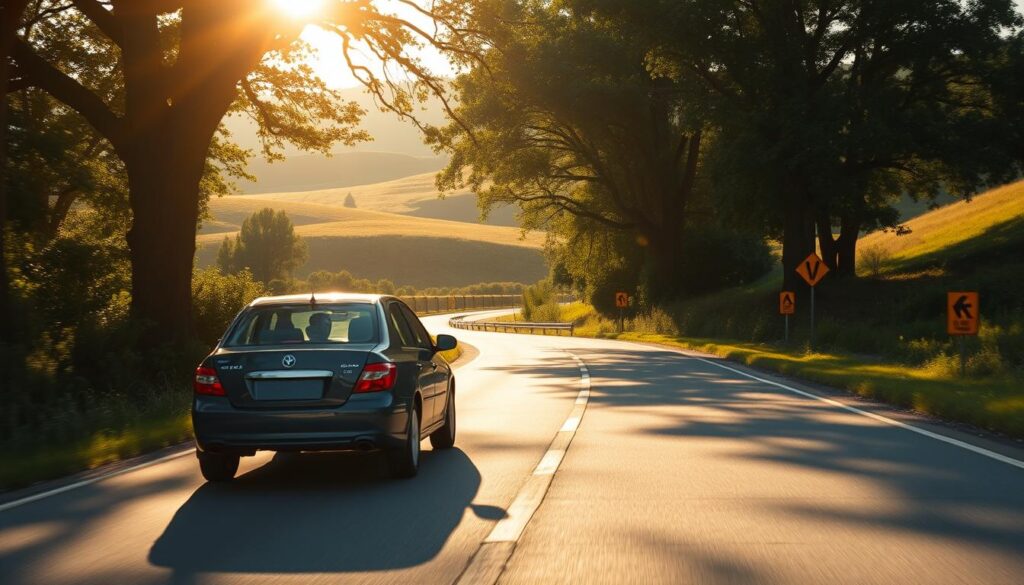
| Safety Tips | Statistics |
|---|---|
| Use of Seat Belts | 83% of occupants wear seat belts, significantly reducing fatalities18. |
| Driver Awareness | Distracted driving accounts for 9% of fatal crashes18. |
| Fatigue Management | Fatigue contributes to 20% of accidents; regular breaks are essential19. |
| Accident Frequency | Road accidents occur every 60 seconds in the U.S., underscoring the need for vigilance18. |
Embrace Flexibility
One of the best aspects of road trips is the freedom they offer. Maintaining a flexible itinerary allows you to explore and adapt your plans as you travel. Be open to last-minute changes that might lead to exhilarating surprises.
Be Open to Last-Minute Changes
Consider the unexpected as one of your road trip’s most flavorful ingredients. You may discover a cozy diner or a stunning viewpoint that wasn’t on your radar. Engaging with travel spontaneity enhances the journey, promoting countless unique experiences that static plans can’t capture. Studies indicate that flexible travel planning, which allows for spontaneous detours, can greatly enrich the travel experience, with 60% of individuals stating that unexpected stops resulted in memorable moments21.
Allow Time for Spontaneity
When crafting your route, it’s essential to factor in opportunities for unplanned adventures. Permit yourself some downtime; this can encourage exploration and allow you to embrace sudden attractions you might encounter. American road trips are renowned as cultural phenomena, captivating travelers who venture to experience the diverse scenic routes throughout the US, from Route 66’s extensive 2,448 miles to the breathtaking views along California’s Highway 122. Adding pauses for spontaneity makes your trip richer and significantly enjoyable.

| Aspect | Effect |
|---|---|
| Flexible Itinerary | Enhances memorable experiences |
| Last-Minute Changes | Increases adventure and excitement |
| Travel Spontaneity | Encourages exploration of unexpected attractions |
| Planned Breaks | Mitigates fatigue during long drives |
Ultimately, embracing flexibility on your road trip adds a layer of excitement and spontaneity that can lead to delightful surprises and enduring memories2221.
Capture the Memories
Documenting your travels enriches your experiences and allows you to relive your adventures for years to come. By incorporating photography, you can capture moments that reflect the beauty and joy of your journey.
Take Photos and Videos
Photography provides a unique visual narrative of your trip. Many photographers believe that the best light for capturing stunning images occurs within 30 minutes after sunrise23. Experiment with different settings and subjects, like incorporating foreground elements for enhanced composition. You can create a DIY travel pin map to mark the places you’ve visited, making every trip memorable24. Additionally, the convenience of mobile devices for photography showcases a shift towards accessible technology23.
Keep a Travel Journal
Maintaining a travel journal becomes essential for preserving your stories and experiences. This journal serves as a means to reflect on your adventures, allowing for a connection with future generations24. Capture daily memories and emotions to enrich your reflections later. Incorporating memorabilia like postcards or snippets of your trip can visually document your journey and enhance the storytelling process24. Don’t forget to write down the minutiae of your travels; these details often make the most compelling stories23.
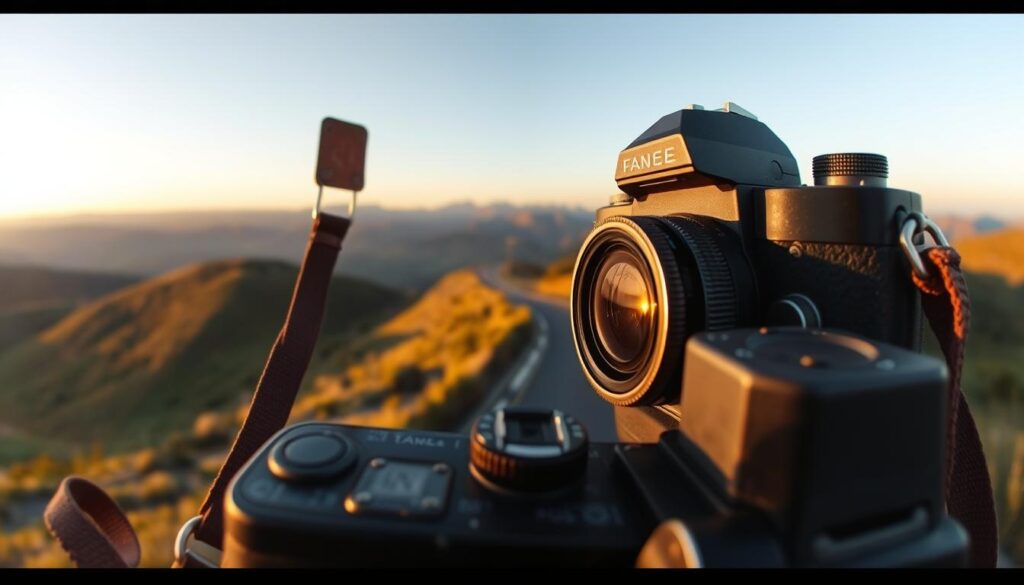
Reflect on Your Experience
After a road trip, taking a moment for travel reflection is invaluable. Engaging in discussions with your travel companions about the highlights of the journey not only fosters camaraderie but also opens avenues for wonderful storytelling. Many travelers find that sharing experiences allows them to look back fondly on their adventures and creates deeper connections with those they traveled with.
Discuss Highlights with Travel Companions
By sharing insights on what worked well during the trip and what could be improved, you can gather valuable information for future travels. For instance, discussing how certain scenic routes added enjoyment can highlight the preference many have for beautiful landscapes, as indicated by research showing that 35% of travelers took a trip specifically for the views25. Take note of these interactions; they can significantly enhance the enjoyment of your next adventure.
Share Insights for Future Trips
Through travel reflection, the memories you create can influence your planning for future journeys. Understanding that the average American road trip covers around 600 miles and typically extends over several hours can help you design a more enjoyable experience26. The knowledge gained from discussing your adventures can transform each subsequent road trip into an even more fulfilling experience, with the potential to create memories that rival the destinations themselves27.
